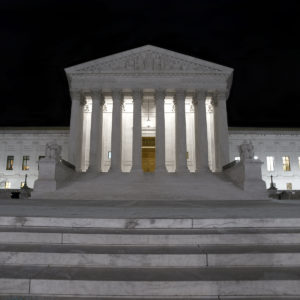Few presidential elections have featured federal court judges among their top five issues. The Supreme Court’s odious decision in the Dred Scott case was a central theme in the 1860 race between Abraham Lincoln and Stephen Douglas. And several controversial decisions by the Warren Court were front and center in the 1968 faceoff between Richard Nixon and Hubert Humphrey.
This may well be another such year. Court-related issues far beyond who will fill the vacancy created by the unexpected death of Supreme Court Justice Antonin Scalia loom large.
Of course, who becomes the ninth justice will have a long-lasting effect on U.S. governance. For years the Supreme Court has been closely divided on a number of contentious issues: the Second Amendment (Heller, McDonald), religious liberty (Hobby Lobby, Town of Greece), the First Amendment (Citizens United), voting rights (Shelby County), racial preferences (Fisher I), and the death penalty (Glossip), among others. In each of these cases (considered victories for the conservative wing of the court), Justice Scalia’s vote made the difference.
The importance of the Scalia vacancy was also evident in the last few months of this past term, as the remaining eight justices divided evenly on significant cases involving free speech, compulsory union dues (Friedrichs), and President Obama’s executive action on immigration (Texas).
Other vacancies may also arise. On the day our next president takes the oath of office, Justices Ruth Bader Ginsburg will be 83, Anthony Kennedy (long considered the pivotal swing vote on the court) will be 80, and Stephen Breyer will be 78 years. All three have already exceeded the average life expectancy for men and women in this country.
Other courts are at stake, as well. And they also matter.
The Supreme Court receives roughly 7,000 petitions every year, but agrees to hear only about 70. Because so few cases ever reach the high court, it is critical that the president nominate good judges to the lower federal district and appellate courts. Over an eight-year period, a president will typically get to nominate a full third of the federal judiciary. When President Obama took office, only one of the 13 federal appellate courts had a majority of Democratic appointees; today, it’s nine.
With lifetime appointments, all federal court judges, but most particularly Supreme Court justices, exert substantial influence over the development and application of the law for decades. As former Attorney General Ed Meese has stated, “No president exercises any power more far-reaching, more likely to influence his legacy, than the selection of federal judges.”
When it comes to nominating those judges, it makes a big difference who sits in the Oval Office. Ronald Reagan looked for judges who would “protect the integrity of the Constitution, not … add to it or subtract from it — certainly not … rewrite it,” while President Obama views the “quality of empathy of understanding and identifying with people’s hopes and struggles as an essential ingredient for arriving at just decisions and outcomes.”
In our view, when it comes to interpreting statutes and the Constitution, judges should keep uppermost in mind that they did not write the text. Therefore, they must not attempt to rewrite that text through creative “interpretation” to mean something quite different from what its authors intended but which they personally consider to be more fair, wise or just. In other words, a judge should interpret the text and structure of the law based on the original public meaning of that text at the time it was adopted, and should not, under the guise of statutory or constitutional interpretation, impose his or her own policy predilections on the rest of society.
On the occasion of nominating Chief Justice William Rehnquist and Justice Scalia, President Reagan reminded us that Supreme Court justices “must not only be jurists of the highest competence; they must also be attentive to the rights specifically guaranteed in our Constitution and to the proper role of the courts in our democratic system.”
The same could be said of all federal judges. The next president will have the opportunity to leave a massive imprint on the federal courts for a generation or more. The stakes are high indeed.

